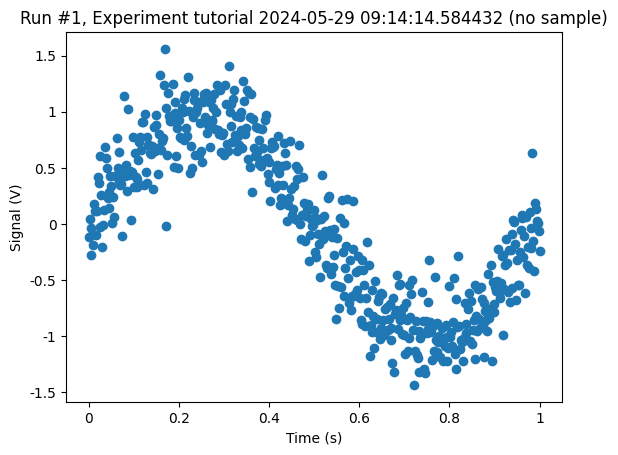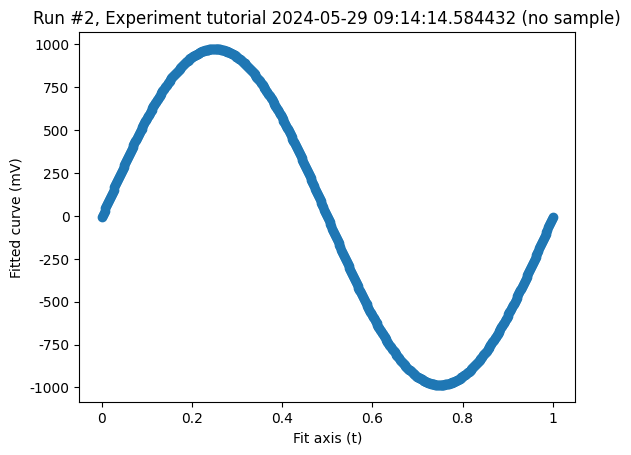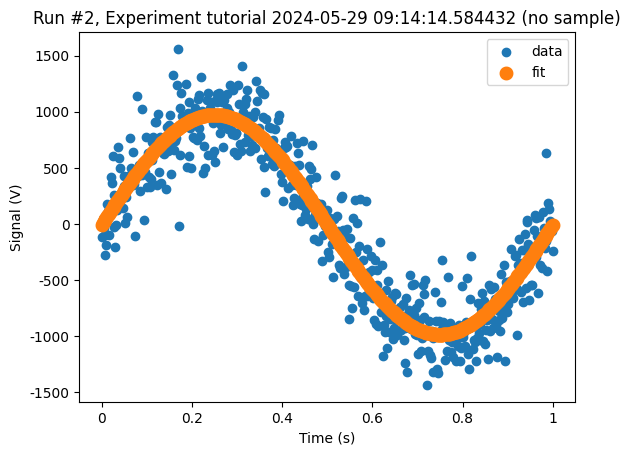This page was generated from
docs/examples/DataSet/Linking to parent datasets.ipynb.
Interactive online version:
.
Linking to parent datasets¶
When performing a measurement in QCoDeS, it is possible to annotate the outcome (the dataset) of that measurement as having one or more parent datasets. This is done by adding a link to each parent dataset. This notebook covers the mechanisms to do that by going through a few practical examples.
[1]:
import datetime
from pathlib import Path
import matplotlib.pyplot as plt
import numpy as np
import scipy.optimize as opt
from qcodes.dataset import (
Measurement,
initialise_or_create_database_at,
load_by_run_spec,
load_or_create_experiment,
plot_dataset,
)
[2]:
now = str(datetime.datetime.now())
tutorial_db_path = Path.cwd().parent / "example_output" / "linking_datasets_tutorial.db"
initialise_or_create_database_at(tutorial_db_path)
load_or_create_experiment("tutorial " + now, "no sample")
[2]:
tutorial 2026-01-15 09:00:42.349559#no sample#1@/home/runner/work/Qcodes/Qcodes/docs/examples/example_output/linking_datasets_tutorial.db
-----------------------------------------------------------------------------------------------------------------------------------------
Example 1: Measuring and then fitting¶
Say we measure some raw data and subsequently do a curve fit to those data. We’d like to save the fit as a separate dataset that has a link to the dataset of the original data. This is achieved in two steps.
Step 1: measure raw data¶
[3]:
meas = Measurement()
meas.register_custom_parameter(name="time", label="Time", unit="s", paramtype="array")
meas.register_custom_parameter(
name="signal", label="Signal", unit="V", paramtype="array", setpoints=["time"]
)
N = 500
with meas.run() as datasaver:
time_data = np.linspace(0, 1, N)
signal_data = np.sin(2 * np.pi * time_data) + 0.25 * np.random.randn(N)
datasaver.add_result(("time", time_data), ("signal", signal_data))
dataset = datasaver.dataset
Starting experimental run with id: 1.
[4]:
cbs, axs = plot_dataset(dataset)

Step 2: Set up a fit “measurement”¶
We now load the raw data dataset, set up a new measurement for the fit, register the raw data as a parent and save a fit.
As the very first step, we supply a model to fit to.
[5]:
def fit_func(x, a, b):
return a * np.sin(2 * np.pi * x) + b
Next, we set up the fitting measurement.
[6]:
raw_data = load_by_run_spec(captured_run_id=dataset.captured_run_id)
meas = Measurement()
meas.register_custom_parameter(
"fit_axis", label="Fit axis", unit="t", paramtype="array"
)
meas.register_custom_parameter(
"fit_curve",
label="Fitted curve",
unit="V",
paramtype="array",
setpoints=["fit_axis"],
)
meas.register_custom_parameter(
"fit_param_a", label="Fitted parameter amplitude", unit="V"
)
meas.register_custom_parameter("fit_param_b", label="Fitted parameter offset", unit="V")
meas.register_parent(parent=raw_data, link_type="curve fit")
[6]:
<qcodes.dataset.measurements.Measurement at 0x7f3b7b6cb250>
As we now run the measurement, the parent datasets become available via the datasaver. The datasets appear in the order they were registered.
[7]:
with meas.run() as datasaver:
raw = datasaver.parent_datasets[0]
xdata = np.ravel(raw.get_parameter_data()["signal"]["time"])
ydata = np.ravel(raw.get_parameter_data()["signal"]["signal"])
popt, pcov = opt.curve_fit(fit_func, xdata, ydata, p0=[1, 1])
fit_axis = xdata
fit_curve = fit_func(fit_axis, *popt)
datasaver.add_result(
("fit_axis", fit_axis),
("fit_curve", fit_curve),
("fit_param_a", popt[0]),
("fit_param_b", popt[1]),
)
fit_data = datasaver.dataset
Starting experimental run with id: 2.
[8]:
cbs, axs = plot_dataset(fit_data)

And just for completeness, let us plot both datasets on top of each other.
[9]:
fig, ax = plt.subplots(1)
cbs, axs = plot_dataset(raw_data, axes=ax, label="data")
cbs, axs = plot_dataset(fit_data, axes=ax, label="fit", linewidth=4)
ax.set_xlabel("Time (s)")
ax.set_ylabel("Signal (V)")
plt.legend()
[9]:
<matplotlib.legend.Legend at 0x7f3b7b6b0590>

[ ]: